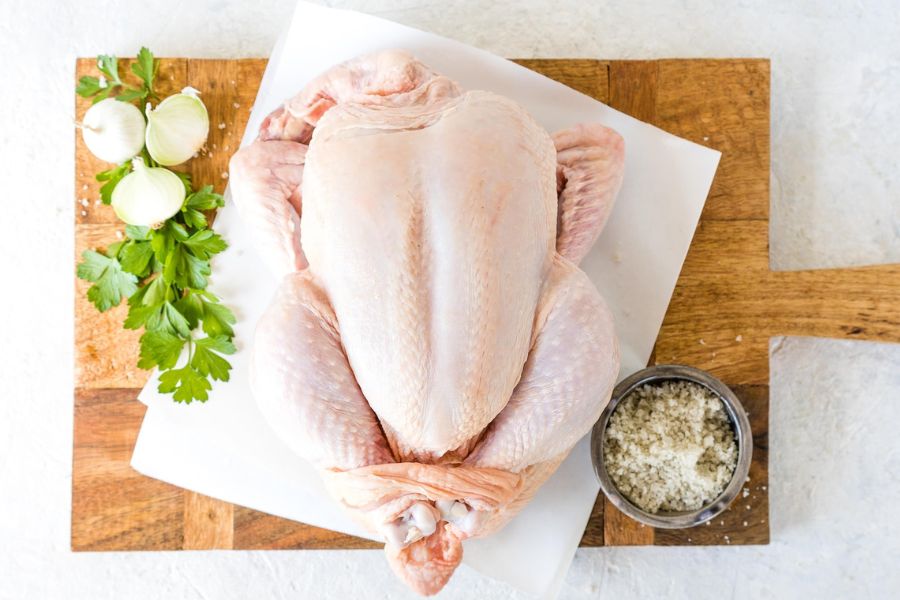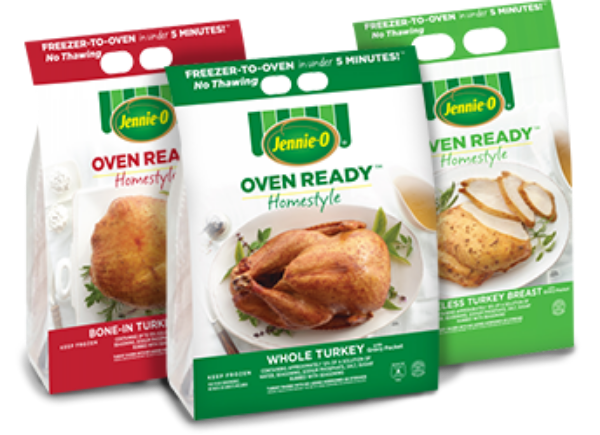Heat oven to 325°F. Remove neck, giblet and gravy packet, if applicable. These may be used to prepare gravy or stuffing.
Place turkey on rack in shallow pan, breast side up, and loosely cover with foil. Remove foil after 1 hour of cooking.
Roast until timer pops up and turkey is fully-cooked, 180°F as measured by a meat thermometer inserted into the thickest part of the thigh. ALWAYS confirm doneness with a meat thermometer. Juices should run clear.
For optimal safety, cook stuffing and turkey separately. If desired, add fully cooked stuffing to cooked turkey just prior to serving.
Can You Cook a Turkey With the Plastic Leg Holder Attached?
As Thanksgiving approaches, home cooks across the country are gearing up to roast the star of the holiday meal – the turkey When purchasing a whole turkey from the grocery store, you may have noticed a plastic device holding the legs together This handy little contraption is called a hock lock. It keeps the legs neatly tucked to prevent flopping during processing and packaging.
Naturally, this prompts the question – can you cook a turkey with the plastic leg holder still attached? The short answer is yes. The hock lock is made from heat-resistant nylon that can withstand temperatures up to 500°F. As long as you are roasting or baking the turkey, it is perfectly safe to leave it on. However, if you plan to deep fry your bird, you should remove the hock lock prior to cooking.
What Exactly is a Hock Lock?
As mentioned above, a hock lock is the technical name for that plastic clamp keeping the turkey’s legs together. Hock refers to the joint between the thigh and drumstick on poultry. These devices are designed to hold the hocks or legs in place so they don’t move around during transportation and storage.
In the past, hock locks were typically made of metal. But today, most turkey producers use food-safe nylon instead. The material needs to be laboratory tested to confirm it won’t release any harmful chemicals when exposed to high heat. As long as proper protocols are followed, the USDA has no issue with legs remaining trussed for roasting.
Pros and Cons of Leaving It On
There are a few advantages to leaving the hock lock intact:
-
It keeps the legs neatly tucked in and maintains the turkey’s shape. This can provide a nice presentation when serving.
-
With the legs secured, it may help the bird remain stable when placed breast-side up on a roasting rack.
-
Since the plastic is heat-resistant, you don’t have to worry about any melting or burning.
However, there are also some drawbacks to consider:
-
Trussing the legs can make it more challenging to ensure even cooking between the breast and thighs. The closed position prevents heat from circulating properly.
-
It may be difficult to see if the giblets were removed prior to cooking. Nothing would ruin Thanksgiving faster than biting into the bag of organs!
-
Stuffing the cavity can be trickier with the legs fastened shut.
Should You Remove the Hock Lock?
This decision comes down to personal preference. Many home cooks choose to remove it simply for easier handling. If you want to untruss the bird, just use kitchen shears or scissors to snip the nylon and release the legs. Be sure to wash the tool after touching raw poultry.
Without the hock lock, some chefs recommend tying the legs together with butcher’s twine or tucking the tips under the body. This still keeps everything tucked in neatly for cooking.
Others see no issue leaving the plastic on if they prefer the trussed shape. As long as you reach a safe minimum internal temperature of 165°F, the USDA confirms it is perfectly fine to roast the turkey with the original leg holder.
What About the Pop-Up Temperature Indicator?
Some fresh turkeys also come equipped with a plastic pop-up timer. When the breast meat hits 165°F, the indicator will pop up to signal doneness. This functions much like the pop-up timers found in many roasting chickens.
The pop-up timer is also made from food-safe, heat-resistant plastic. So you can leave it in place while the turkey roasts in the oven. However, it should be removed prior to deep frying for safety. Since you can’t see the pop-up while the bird is submerged, it really serves no purpose anyway.
For most home chefs, using an instant-read meat thermometer to check the inner thigh and breast temp is the best way to confirm doneness. The pop-up timers are handy backup indicators, but should not replace taking exact temperature readings in multiple spots.
Other Safety Tips for Turkey Time
Handling raw poultry can lead to cross-contamination in the kitchen if proper precautions aren’t taken. Here are some key food safety guidelines for the big meal:
-
Never place cooked turkey back on any surface or cutting board that previously held raw meat.
-
Use separate utensils for handling raw vs. cooked turkey. Be diligent about washing hands, sinks, knives, and prep tools.
-
Refrigerate all leftovers within 2 hours of coming off the grill or out of the oven.
-
Store leftovers in shallow containers to allow rapid cooling. Reheat fully to 165°F before serving again.
-
Freeze any turkey leftovers you don’t plan to eat within 3-4 days.
-
Defrost frozen turkey safely in the refrigerator, never on the countertop.
What If You Leave the Giblets Bag Inside?
In the rush to get Thanksgiving dinner on the table, it’s not uncommon for home cooks to accidentally leave the giblets bag inside the turkey cavity. If the wrapper is paper, you’re in the clear. The USDA confirms it’s fine to cook and eat the turkey and giblets as long as the minimum internal temp has been reached. Just be sure to remove the bag and inspect the contents before consuming.
However, if the wrapper is plastic and appears damaged or melted, it’s best to throw away the turkey. The breakdown of the material could potentially leach harmful chemicals into the surrounding meat. When in doubt, remember it’s better to be safe than sorry!
The Bottom Line
At the end of the day, leaving the plastic hock lock on or off comes down to cook’s choice. The nylon is heat-safe up to 500°F so it will not melt or release chemicals into the oven. But some home chefs prefer to untruss the legs for easier maneuverability.
As long as you take care to properly thaw, handle, cook, and store your turkey, it will turn out tasty and safe to eat for the big feast. Just be sure to keep food safety top of mind when prepping your bird. Follow the recommended guidelines and you’ll have a delicious, memorable holiday meal.

HOW MUCH TURKEY DO I NEED?ADULTSKIDS LEFTOVERS BIG EATERS

Turkey Weight & Cooking Times
- 8-12 pounds, 3-1/2 hours to 4 hours.
- 12-18 pounds, 4-1/4 hours to 4-3/4 hours.
- 18-22 pounds, 4-1/2 hours to 5 hours.
- 22-24 pounds, 4-3/4 to 5-1/4 hours.
Wash hands and all items that come into contact with uncooked turkey.
Find more whole turkey basics here. Previous How Tos
Retro Recipe: Roast turkey leg with stuffing
FAQ
Do I need to remove the plastic from turkey legs?
Can you deep fry a turkey with the plastic leg holder?
Do you cook a turkey with the legs tied?
Are plastic turkey leg holders safe?
If the leg holder is not secure, it could come loose and allow the turkey to fall over. This could cause the turkey to cook unevenly and could also result in burns. Overall, plastic leg holders are a safe and effective way to cook a turkey. When used properly, they can help to ensure that the turkey cooks evenly and safely.
What is a turkey leg holder?
The plastic leg holder is a device that helps to keep the turkey legs from falling off during cooking. It is typically made of a heat-resistant plastic and has two pieces that fit around the turkey’s legs. The plastic leg holder can be placed in the oven with the turkey and will help to keep the turkey legs from drying out.
Can you cook Turkey with a plastic leg holder?
Yes, you can cook turkey with the plastic leg holder. The plastic leg holder is a device that helps to keep the turkey legs from falling off during cooking. It is typically made of a heat-resistant plastic and has two pieces that fit around the turkey’s legs.
How do you use a plastic leg holder?
1. Place the turkey breast-side up on a roasting pan. 2. Insert the two pieces of the plastic leg holder around the turkey’s legs. 3. Secure the plastic leg holder in place with a piece of kitchen twine. 4. Cook the turkey according to the recipe. What are the benefits of using a plastic leg holder?
